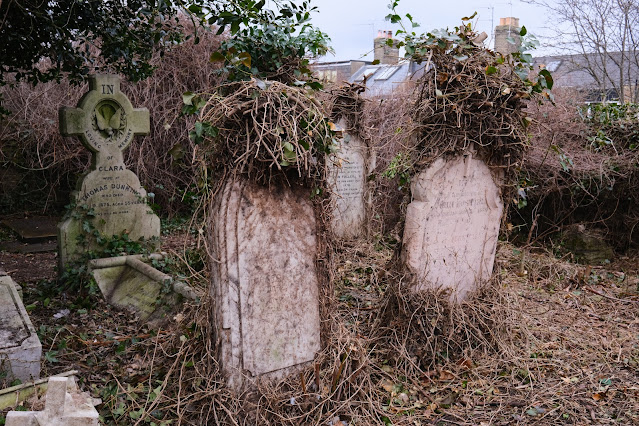Naturalizing Christianity
Taken with a Fuji X100V using Øyvind Nordhagen’s Kodak Ektar 100 Recipe
Just click on a photo to enlarge it.
It has long struck me that, in the European and North American context anyway, Christianity, if it is to survive as a living and relevant religious tradition in the twenty-first century, needs consciously to naturalize itself; it needs to find ways to become an explicitly, religious naturalist tradition, or so I think. But I would think that, of course, because I’m a reasonably long-standing member of the Religious Naturalist Association (RNA) and am also the convener of the RNA’s Clergy Group.
One of the places I regularly find this naturalizing process of Christianity at work in a very visible fashion is in graveyards and churchyards. Walking around them (which I regularly do), I find, again and again, many examples of Christian graves and symbols (such as crosses and statues) being slowly taken back into nature’s wild body through the action of the earth, ivy, shrubs and trees. Occasionally, this process of naturalization is particularly revealed when some attempt to halt the process is made and the ivy, shrubs and trees are cleared away. I saw an excellent example of this today in the Mill Road Cemetery in Cambridge and, for your pleasure, I took a few photos which I include in this post. The process of Christianity being taken back into nature’s wild body may have been slowed by this action, but it has assuredly not been stopped!
One particularly beautiful, poetic expression of this process of naturalization can be found in Thomas Hardy’s poem, “Voices From Things Growing in a Churchyard”, which you can read at this link.
If you are interested in reading a recent, excellent philosophical/theological expression of the naturalization of Christianity, you can do no better than checking out Karl E. Peters’s latest book (2022) called Christian Naturalism: Christian Thinking for Living in This World Only. The publisher’s blurb reads as follows:
“Is it possible to believe that our life in this world is all there is and be Christian? Karl Peters says yes. We can think about God as the creativity of the world. About our life as beginning when we were hydrogen atoms, so that everything is family. About how the evils of sexism, racism, and speciesism (climate change) arose in human history. Peters says that Jesus is fully human. His mother, Mary, was raped by a Roman soldier. And he is savior by being an inspiring moral example of how we should live—loving God completely and our neighbor as ourselves. Through evolution we are related to everything else. Therefore, we should love as family all varieties of humans, other species, and the planet itself.”
“Is it possible to believe that our life in this world is all there is and be Christian? Karl Peters says yes. We can think about God as the creativity of the world. About our life as beginning when we were hydrogen atoms, so that everything is family. About how the evils of sexism, racism, and speciesism (climate change) arose in human history. Peters says that Jesus is fully human. His mother, Mary, was raped by a Roman soldier. And he is savior by being an inspiring moral example of how we should live—loving God completely and our neighbor as ourselves. Through evolution we are related to everything else. Therefore, we should love as family all varieties of humans, other species, and the planet itself.”
And so now, to the photos . . .









Comments